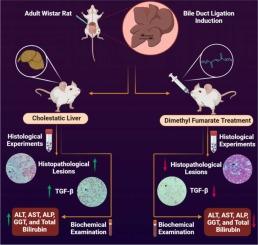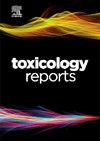Evaluation of the effects of dimethyl fumarate on transforming growth factor beta levels in the liver of rats with bile duct ligation-induced cholestasis
Q1 Environmental Science
引用次数: 0
Abstract
Background
Cholestasis is a reduction or cessation of bile flow in the biliary system, which can be life-threatening. Dimethyl Fumarate could induce anti-inflammatory and antioxidant effects in the body.
Objective
This investigation focused on assessing the impact of Dimethyl Fumarate on liver levels of transforming growth factor beta (TGF-β) to mitigate biochemical, histopathological, and immunohistochemical alterations in cholestasis-induced rat models.
Methods
Forty male adult Wistar rats were divided into eight groups (healthy control treated with distilled water, healthy rats treated with 50, 100, and 200 mg/kg of Dimethyl Fumarate, bile duct ligation (BDL), and experiment BDL groups were treated with 50, 100, and 200 mg/kg of Dimethyl Fumarate). After the gavage treatment period of 45 days, the rats were anesthetized and underwent blood sampling. Liver damage was assessed by measuring hepatic marker enzymes (alanine transaminase, aspartate transaminase, alkaline phosphatase, gamma-glutamyl transferase, and total bilirubin), histopathological (lesion assessment), and immunohistochemical (TGF-β expression level) observation.
Results
The findings demonstrated that administration of varying doses of Dimethyl Fumarate via gavage led to a statistically significant reduction in serum concentrations of alanine aminotransferase, aspartate aminotransferase, alkaline phosphatase, gamma-glutamyl transferase, and total bilirubin (P < 0.05). The optimal dosage identified was 200 mg/kg of Dimethyl Fumarate. Furthermore, the data indicated that gavage treatment with Dimethyl Fumarate significantly attenuated TGF-β expression level and mitigated hepatic damage (P < 0.05).
Conclusion
This strategy may reduce inflammation, cholestasis, and fibrosis outcomes, attributed to its anti-inflammatory and antioxidant properties. Nonetheless, further research is necessary to substantiate these findings.

富马酸二甲酯对胆管结扎致胆汁淤积大鼠肝脏转化生长因子β水平影响的评价
背景:胆汁淤积症是指胆道系统中胆汁流动减少或停止,可能危及生命。富马酸二甲酯在体内具有抗炎、抗氧化作用。目的研究富马酸二甲酯对肝脏转化生长因子β (TGF-β)水平的影响,以减轻胆汁沉积诱导大鼠模型的生化、组织病理学和免疫组织化学改变。方法40只雄性成年Wistar大鼠分为8组(健康对照组用蒸馏水处理,健康大鼠用50、100、200 mg/kg富马酸二甲酯胆管结扎(BDL)处理,试验组用50、100、200 mg/kg富马酸二甲酯胆管结扎)。灌胃45 d后,大鼠麻醉并采血。通过检测肝脏标志物酶(丙氨酸转氨酶、天冬氨酸转氨酶、碱性磷酸酶、γ -谷氨酰转移酶、总胆红素)、组织病理学(病变评估)和免疫组化(TGF-β表达水平)观察来评估肝损害。结果不同剂量富马酸二甲酯灌胃可显著降低血清丙氨酸转氨酶、天冬氨酸转氨酶、碱性磷酸酶、γ -谷氨酰转移酶和总胆红素浓度(P <; 0.05)。确定的最佳用量为200 mg/kg富马酸二甲酯。此外,富马酸二甲酯灌胃可显著降低TGF-β表达水平,减轻肝损害(P <; 0.05)。结论:由于其抗炎和抗氧化特性,该策略可减少炎症、胆汁淤积和纤维化结果。然而,需要进一步的研究来证实这些发现。
本文章由计算机程序翻译,如有差异,请以英文原文为准。
求助全文
约1分钟内获得全文
求助全文
来源期刊

Toxicology Reports
Environmental Science-Health, Toxicology and Mutagenesis
CiteScore
7.60
自引率
0.00%
发文量
228
审稿时长
11 weeks
 求助内容:
求助内容: 应助结果提醒方式:
应助结果提醒方式:


